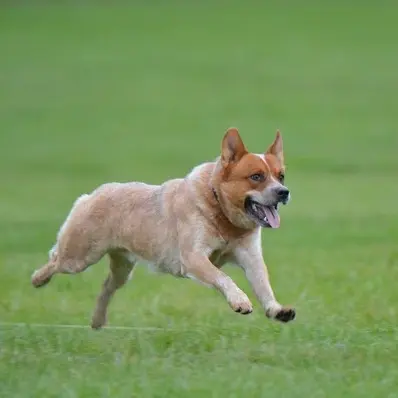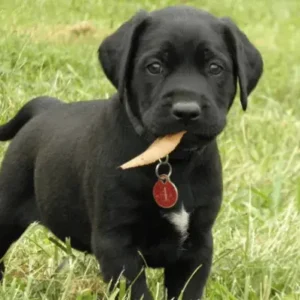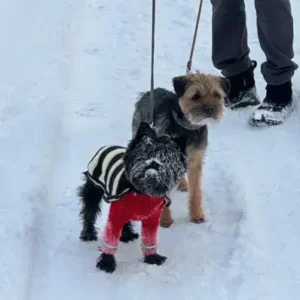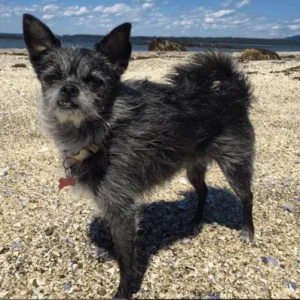Australian Cattle Dog History/Origin
In the 19th century, as British colonialist settlers sought to establish their cattle industry across Australia, they needed capable and resilient herding dogs.
Imported herding dogs from England initially struggled to adapt to the harsh Australian conditions. This made the settler, Thompson Simpson Hall, seek a solution to withstand the demanding environment. He is credited to have bred the possible ancestor of the current Australian Cattle Dog, the Blue Heelers.
These early crossbreeds displayed remarkable intelligence, endurance, and an instinct for herding cattle. Over time, pioneering ranchers like Robert Kaleski selectively bred the Australian Cattle Dog for its unique blue coat and exceptional herding skills.
Originally referred to as Blue Heelers or Queensland Heelers, these purebred dogs quickly gained popularity among Australian ranchers, particularly in Queensland.
Here they became indispensable partners in managing cattle. The breed’s reputation for reliability and toughness spread rapidly. This led to its recognition by kennel clubs and the establishment of a formal breed standard in the early 20th century.
Australian Cattle Dog photographed in 1902- Source: Wikipedia
Despite its origins in Australia, the breed’s appeal transcended borders, attracting attention and admiration from dog enthusiasts worldwide. In 1980, the Australian Cattle Dog was recognized by the American Kennel Club under Herding Group.
US Soldier with Australian Cattle Dog -Source: Wikipedia
Today, the Australian Cattle Dog remains true to its heritage as a loyal and hardworking companion.
Australian Cattle Dog Personality
Australian Cattle Dogs are one of the dog breed that are known for being active and full of energy. They were bred as working dogs, so they’re great at staying focused on tasks.
They’re intelligent dogs and can learn new things quickly. Sometimes they can be a bit stubborn, especially if they feel like they need to get clear directions from their owners.
- Australian Cattle Dog Temperament
They’re devoted to their owners and will do their best to protect them. They might be a little wary around strangers. With some early socialization, they can learn to be more comfortable around new people.
Despite their serious side, Australian Cattle Dogs love to play and cuddle with their families. They enjoy activities like running, hiking, and playing games. But keeping them busy is important because they have a lot of energy to burn!
These dogs need owners who are committed to giving them plenty of exercise, training, and attention. Without these things, they might get bored and start causing trouble around the house.
In short, Australian Cattle Dogs are smart, loyal, and energetic companions who love to work and play with their families. They’re great pets for people who are ready to give them the love and care they need.
However, due to their high energy levels and strength, it’s better to not have them if you have young children at home.
- Challenges
It’s essential to acknowledge that Australian Cattle Dogs are not without their challenges. Their high energy levels and need for mental stimulation require dedicated time and effort from their owners.
Without sufficient exercise and enrichment, they may exhibit undesirable behaviors such as excessive barking, destructive chewing, or escape attempts.
Additionally, Australian Cattle Dogs are known for their independent streak and strong-willed nature.
While this trait reflects their intelligence and problem-solving abilities, it can also manifest as stubbornness. Consistent training and positive reinforcement techniques are required to channel their energy effectively.
Australian Cattle Dog Physical Appearance
The Australian Cattle Dog breed presents a robust and athletic build, showing strength and agility. Their well-balanced proportions and muscular frame reflect their heritage as working dogs bred for demanding tasks.
Their eyes are typically oval-shaped and alert, often harmonizing with their coat color, with shades of brown or amber being common.
They have medium-sized ears that stand erect when alert. Its head is broad and slightly rounded. Their skull is well-developed, with a pronounced stop and a distinct furrow between the eyes.
- Australian Cattle Dog Size
They typically have a medium-sized, muscular build, with a sturdy frame that reflects their strength and agility.
The typical American Cattle Dog weight ranges from 35 to 50 pounds (16 to 23 kg). Males are generally larger and heavier than females. They typically stand between 17 to 20 inches (43 to 51 cm) tall at the shoulder.
Mini Australian Cattle Dog – Source: australian.cattle.dog
- Australian Cattle Dog Coat Color
Their coats can come in variations of blue and red, including blue mottled or red Australian Cattle Dog.
These distinct coat colors have earned them the names Blue Heelers and Red Heelers. People often confuse Blue Australian Cattle dogs as a separate breed due to their name, Blue Heeler, when in fact they’re the same breed. Additionally, there is no such dog as a white Australian cattle dog.
Australian Cattle Dogs have a short double coat, consisting of a dense undercoat and a harsh outer coat. This combination provides them with protection from various weather conditions, making them well-suited to both extreme cold and hot weather.
Blue mottled Australian Cattle Dog- Source: Britannica
Red mottled Australian Cattle Dog- Source: Pixabay
Australian Cattle Dog Gender Differences
Male Australian Cattle Dogs are usually a bit bigger and heavier than females. This means that male dogs of this breed tend to be larger and weigh more than female dogs.
Apart from size, there might also be differences in behavior between male and female Australian Cattle Dogs. Males may show more dominance, while females might be more nurturing. However, every dog is unique, so it’s essential to consider individual personality traits when choosing a pet.
Australian Cattle Dog Feed/Nutrition
Australian Cattle Dogs require proper nutrition for their health and well-being. Their diet should be planned according to their age, size, and activity level to thrive.
A balanced diet for this high-energy breed should primarily consist of high-quality protein sources to support their muscular build and active lifestyle. Look for dog foods with meat as the main ingredient, such as chicken, beef, shrimp or fish.
In addition to protein, their diet should include carbohydrates for energy, essential fatty acids for coat and skin health, and a variety of vitamins and minerals for overall wellness.
It’s essential to monitor their food intake and adjust portions accordingly to prevent overeating and obesity. Providing access to fresh water at all times is also essential to keep them hydrated, especially during periods of physical activity.
While commercial dog food is fine, you can also give them some fruits and veggies as treats. Just make sure to avoid foods that can be harmful to dogs, like grapes or chocolate.
Regular visits to the vet will help you keep an eye on their weight and make sure they’re getting the right nutrition.
Australian Cattle Dog Health
Australian Cattle Dogs are generally healthy dogs, but they may be prone to common health conditions such as:
- Progressive Retinal Atrophy: Progressive retinal atrophy is a genetic eye disorder that leads to gradual degeneration of the retina, eventually resulting in blindness. While there is no cure for PRA, early detection through veterinary exams can help manage the condition and slow its progression.
- Hip Dysplasia: Hip dysplasia is a common orthopedic condition in dogs, including Australian Cattle Dogs, where the hip joint develops abnormally. This can lead to discomfort, pain, and mobility issues as the dog ages. Treatment options range from medication and supplements to surgical intervention, depending on the severity of the condition.
- Deafness: This can be present at birth or develop over time and may affect one or both ears. Dogs with congenital deafness are typically born without the ability to hear, while acquired deafness may result from factors such as aging, injury, or exposure to loud noises. While deafness can pose communication challenges, many deaf dogs lead happy and fulfilling lives with proper training and accommodations.
Ensure your Australian Cattle Dog’s well-being with regular vet check-ups for vaccinations and parasite control. Maintain dental health with brushing and dental chews. Provide a balanced diet and monitor weight to prevent obesity-related issues.
Australian Cattle Dog Care and Grooming
Taking care of an Australian Cattle Dog’s coat is pretty easy and their coat is low-maintenance. They have a short coat that doesn’t need a lot of brushing except during shedding season, which happens once or twice a year. During shedding, you might need to brush them every day to keep their coat in check.
Because their coat is short, they don’t get dirty easily, so they don’t need baths very often. You can bath them when they start to smell or get visibly dirty, but it’s not something you’ll need to do regularly.
Besides brushing and bathing, it’s important to trim their nails, clean their ears, and brush their teeth regularly. These simple grooming tasks help keep them looking and feeling their best. Additionally, house training your dog is essential for a clean and comfortable home environment.
Australian Cattle Dog Rescue Groups
Are you considering Australian Cattle Dog adoption? Several rescue organizations specialize in Australian Cattle Dogs and work to rehome abandoned or surrendered dogs. Adopting from a rescue group can be a rewarding way to bring an Australian Cattle Dog into your home.
Australian Cattle Dog Price
The typical Australian Cattle Dog price ranges from $400 to $700. It’s crucial to find a good breeder who cares about their dogs’ health and happiness when you are about to buy or adopt an Australian cattle dog. Avoid places like puppy mills where dogs might not be treated well.
Interesting Facts
- The Australian Cattle dog named Bluey holds the Guinness World Record for being the oldest lived dog verified. Bluey lived up to 29 years and 5 months before being euthanized.
Bluey- Source: Blue Mountain Gazette
- In 2007, Teka, a three-year-old Australian Cattle dog saved her 79-year-old owner’s life by allegedly performing CPR on him when he suffered from a major heart attack. She was awarded a medal for her effort by the RSPCA.
- One of the most famous Australian Cattle Dogs in film history is the one who appeared in “Mad Max 2: The Road Warrior.”
Mad Max 2 The Road Warrior- Source: Pinterest
- Australian Cattle Dog being featured in breed judging show in 2023.
Best For
Australian Cattle Dogs are great at many things, like herding, agility, obedience, and being loyal family pets. They’re smart and athletic, so they’re perfect for active families who can give them lots of exercise and playtime.
Australian Cattle Dog Top Names
| Male Australian Cattle Dog Names | Female Australian Cattle Dog Names |
| Blue | Luna |
| Ace | Nova |
| Ranger | Ember |
| Duke | Pepper |
| Bolt | Zara |









 Australian Cattle Dog photographed in 1902- Source:
Australian Cattle Dog photographed in 1902- Source:  US Soldier with Australian Cattle Dog -Source:
US Soldier with Australian Cattle Dog -Source: 

 Mini Australian Cattle Dog – Source:
Mini Australian Cattle Dog – Source:  Blue mottled Australian Cattle Dog- Source:
Blue mottled Australian Cattle Dog- Source:  Red mottled Australian Cattle Dog- Source:
Red mottled Australian Cattle Dog- Source: 
 Bluey- Source:
Bluey- Source:  Mad Max 2 The Road Warrior- Source:
Mad Max 2 The Road Warrior- Source: 






